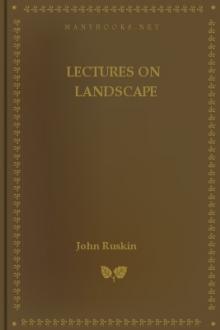The Crown of Wild Olive by John Ruskin (a court of thorns and roses ebook free .TXT) 📕

- Author: John Ruskin
- Performer: -
Book online «The Crown of Wild Olive by John Ruskin (a court of thorns and roses ebook free .TXT) 📕». Author John Ruskin
You see also, by this interesting and most memorable passage, how completely the question is admitted to be one of ethics—the only real point at issue being, whether this face or that is developed on the truer moral principle.
140. I assume, however, for the present, that this Apolline type is the kind of form you wish to reach and to represent. And now observe, instantly, the whole question of manner of imitation is altered for us. The fins of the fish, the plumes of the swan, and the flowing of the Sun-God's hair are all represented by incisions—but the incisions do sufficiently represent the fin and feather,—they insufficiently represent the hair. If I chose, with a little more care and labor, I could absolutely get the surface of the scales and spines of the fish, and the expression of its mouth; but no quantity of labor would obtain the real surface of a tress of Apollo's hair, and the full expression of his mouth. So that we are compelled at once to call the imagination to help us, and say to it, You know what the Apollo Chrysocomes must be like; finish all this for yourself. Now, the law under which imagination works, is just that of other good workers. "You must give me clear orders; show me what I have to do, and where I am to begin, and let me alone." And the orders can be given, quite clearly, up to a certain point, in form; but they cannot be given clearly in color, now that the subject is subtle. All beauty of this high kind depends on harmony; let but the slightest discord come into it, and the finer the thing is, the more fatal will be the flaw. Now, on a flat surface, I can command my color to be precisely what and where I mean it to be; on a round one I cannot. For all harmony depends, first, on the fixed proportion of the color of the light to that of the relative shadow; and therefore if I fasten my color, I must fasten my shade. But on a round surface the shadow changes at every hour of the day; and therefore all coloring which is expressive of form, is impossible; and if the form is fine, (and here there is nothing but what is fine,) you may bid farewell to color.
141. Farewell to color; that is to say, if the thing is to be seen distinctly, and you have only wise people to show it to; but if it is to be seen indistinctly, at a distance, color may become explanatory; and if you have simple people to show it to, color may be necessary to excite their imaginations, though not to excite yours. And the art is great always by meeting its conditions in the straightest way; and if it is to please a multitude of innocent and bluntly-minded persons, must express itself in the terms that will touch them; else it is not good. And I have to trace for you through the history of the past, and possibilities of the future, the expedients used by great sculptors to obtain clearness, impressiveness, or splendor; and the manner of their appeal to the people, under various light and shadow, and with reference to different degrees of public intelligence: such investigation resolving itself again and again, as we proceed, into questions absolutely ethical; as, for instance, whether color is to be bright or dull,—that is to say, for a populace cheerful or heartless;—whether it is to be delicate or strong,—that is to say, for a populace attentive or careless; whether it is to be a background like the sky, for a procession of young men and maidens, because your populace revere life—or the shadow of the vault behind a corpse stained with drops of blackened blood, for a populace taught to worship Death. Every critical determination of rightness depends on the obedience to some ethic law, by the most rational and, therefore, simplest means. And you see how it depends most, of all things, on whether you are working for chosen persons, or for the mob; for the joy of the boudoir, or of the Borgo. And if for the mob, whether the mob of Olympia, or of St. Antoine. Phidias, showing his Jupiter for the first time, hides behind the temple door to listen, resolved afterwards "ρὑθμιζειν το αγαλμα προς το τοις πλειστοις δοκουν, ου γαρ ἡγειτο μικραν ειναι συμβουλην δημου τοσουτου," and truly, as your people is, in judgment, and in multitude, so must your sculpture be, in glory. An elementary principle which has been too long out of mind.
142. I leave you to consider it, since, for some time, we shall not again be able to take up the inquiries to which it leads. But, ultimately, I do not doubt that you will rest satisfied in these following conclusions:
1. Not only sculpture, but all the other fine arts, must be for the people.
2. They must be didactic to the people, and that as their chief end. The structural arts, didactic in their manner; the graphic arts, in their matter also.
3. And chiefly the great representative and imaginative arts—that is to say, the drama and sculpture—are to teach what is noble in past history, and lovely in existing human and organic life.
4. And the test of right manner of execution in these arts, is that they strike, in the most emphatic manner, the rank of popular minds to which they are addressed.
5. And the test of utmost fineness in execution in these arts, is that they make themselves be forgotten in what they represent; and so fulfil the words of their greatest Master,
[123] See date of delivery of Lecture. The picture was of a peasant girl of eleven or twelve years old, peeling carrots by a cottage fire.
[124] In Durer's "Melencholia."
[125] Turner's, in the Hakewill series.
LECTURE V. STRUCTURE. December, 1870.143. On previous occasions of addressing you, I have endeavoured to show you, first, how sculpture is distinguished from other arts; then its proper subjects, then its proper method in the realization of these subjects. To-day, we must, in the fourth place, consider the means at its command for the accomplishment of these ends; the nature of its materials; and the mechanical or other difficulties of their treatment.
And however doubtful we may have remained, as to the justice of Greek ideals, or propriety of Greek methods of representing them, we may be certain that the example of the Greeks will be instructive in all practical matters relating to this great art, peculiarly their own. I think even the evidence I have already laid before you is enough to convince you, that it was by rightness and reality, not by idealism or delightfulness only, that their minds were finally guided; and I am sure that, before closing the present course, I shall be able so far to complete that evidence, as to prove to you that the commonly received notions of classic art are, not only unfounded, but even in many respects, directly contrary to the truth. You are constantly told that Greece idealized whatever she contemplated. She did the exact contrary: she realized and verified it. You are constantly told she sought only the beautiful. She sought, indeed, with all her heart; but she found, because she never doubted that the search was to be consistent with propriety and common sense. And the first thing you will always discern in Greek work is the first which you ought to discern in all work; namely, that the object of it has been rational, and has been obtained by simple and unostentatious means.
144. "That the object of the work has been rational!" Consider how much that implies. That it should be by all means seen to have been determined upon, and carried through, with sense and discretion; these being gifts of intellect far more precious than any knowledge of mathematics, or of the mechanical resources of art. Therefore, also, that it should be a modest and temperate work, a structure fitted to the actual state of men; proportioned to their actual size, as animals,—to their average strength,—to their true necessities,—and to the degree of easy command they have over the forces and substances of nature.
145. You see how much this law excludes! All that is fondly magnificent, insolently ambitious, or vainly difficult. There is, indeed, such a thing as Magnanimity in design, but never unless it be joined also with modesty and Equanimity. Nothing extravagant, monstrous, strained, or singular, can be structurally beautiful. No towers of Babel envious of the skies; no pyramids in mimicry of the mountains of the earth; no streets that are a weariness to traverse, nor temples that make pigmies of the worshippers.
It is one of the primal merits and decencies of Greek work that it was, on the whole, singularly small in scale, and wholly within reach of sight, to its finest details. And, indeed, the best buildings that I know are thus modest; and some of the best are minute jewel cases for sweet sculpture. The Parthenon would hardly attract notice, if it were set by the Charing Cross Railway Station: the Church of the Miracoli, at Venice, the Chapel of the Rose, at Lucca, and the Chapel of the Thorn, at Pisa, would not, I suppose, all three together, fill the tenth part, cube, of a transept of the Crystal Palace. And they are better so.
146. In the chapter on Power in the "Seven Lamps of Architecture," I have stated what seems, at first, the reverse of what I am saying now; namely, that it is better to have one grand building than any number of mean ones. And that is true, but you cannot command grandeur by size till you can command grace in minuteness; and least of all, remember, will you so command it to-day, when magnitude has become the chief exponent of folly and misery, co-ordinate in the fraternal enormities of the Factory and Poorhouse,—the Barracks and Hospital. And the final law in this matter is, that if you require edifices only for the grace and health of mankind, and build them without pretence and without chicanery, they will be sublime on a modest scale, and lovely with little decoration.
147. From these principles of simplicity and temperance, two very severely fixed laws of construction follow; namely, first, that our structure, to be beautiful, must be produced with tools of men; and secondly, that it must be composed of





Comments (0)